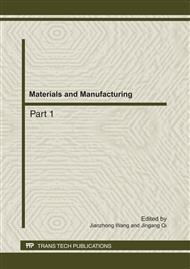[1]
L. Lodgaard, N. Ryum: Mater. Sci. Eng. A Vol. 283(2000), p.144.
Google Scholar
[2]
T. Moons, P. Ratchev and P. De Smet, et al: Scrip. Mater. Vol. 35 (1996), p.939.
Google Scholar
[3]
P. Sepehrband, R, Mahmudi and F, Khomamizadeh: Scrip. Mater. Vol. 52 (2005), p.253.
Google Scholar
[4]
Y.C. Chen, M.E. Fine and J.R. Weertman.: Acta Mater. Vol. 38 (1990), p.771.
Google Scholar
[5]
S. Lkeno, K. Matsuda and K. Nakajima. et al:J. Jpn. Inst. Light Met. Vol. 48 (1998), p.207.
Google Scholar
[6]
S. Takeo,E. Takehiko: Resear. and Develop. Vol. 43 (1993), p.95.
Google Scholar
[7]
D.K. Chatterjee, K.M. Entwistle:J. Jpn. Inst. Light Met. Vol. 101 (1973), p.53.
Google Scholar
[8]
R.J. Livak: Metal. and Mate. Trans. A Vol. 13 (1982), p.1318.
Google Scholar
[9]
S. Hisashi, K. Motohiro and I. Goroh.: J. Jpn. Inst. Light Met. Vol. 30, (1980), p.609.
Google Scholar
[10]
W.F. Miao, D.E. Laughlin: Metal. and Mater. Trans. A Vol. 31 (2000), p.361.
Google Scholar
[11]
K. Matsuda,Y. Uetani and T. Sato, et al: Metal. and Mater. Trans. A Vol. 32 (2001), p.1293.
Google Scholar
[12]
D.J. Chakrabarti, D.E. Laughlin: Prog. Mater. Sci. Vol. 49 (2004), p.389.
Google Scholar
[13]
M. Murayama, K. Hono and W.F. Miao, et al: Metal. and Mater. Trans. A Vol. 32 (2001), p.239.
Google Scholar
[14]
R. S. Yassar, D.P. Field and H. Weiland: Scrip. Mater. Vol. 53(2005), p.299.
Google Scholar
[15]
X. Wang W.J. Poole and S. Esmaeili, et al: Metal. and Mater. Trans. A Vol. 34 (2003), p: 2913.
Google Scholar
[16]
X.J. Jiang, B. Noble and V. Hansen, et al: Metal. and Mater. Trans. A Vol. 32 (2001), p.1063.
Google Scholar
[17]
L. Zhen W.D. Fei: Journal of Mater. Scien. Vol. 32 (1997), p.1895.
Google Scholar
[18]
G.A. Edwards, K. Stiller and G.L. Dunlop, et al: Acta Mater. Vol. 11 (1998), p.3893.
Google Scholar
[19]
A.K. Gupta, D.J. Lloyd and S.A. Court: Mater. Scien. and Eng. A Vol. 316 (2001), p.11.
Google Scholar
[20]
G. Thomas:J. Inst. Met. Vol. 90 (1961-62), p.57.
Google Scholar
[21]
M.H. Jacobs: Philos. Mag. Vol. 26 (1972), p.1.
Google Scholar
[22]
L. Reich, M. Murayama and K. Hono: Acta Mater. Vol. 46 (1998), p.6053.
Google Scholar
[23]
K. Matsuda, D. Teguri and Y. Uetani, et al: Scrip. Mater. Vol. 47 (2002), p.833.
Google Scholar


